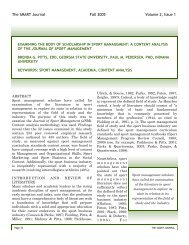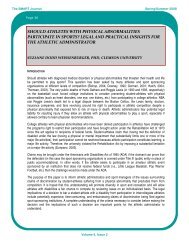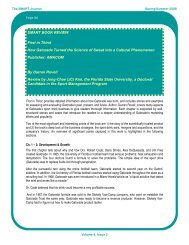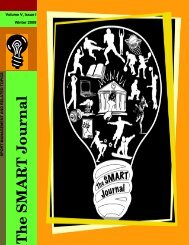Spring/Summer 2008 Volume 4, Issue 2 - The SMART Journal
Spring/Summer 2008 Volume 4, Issue 2 - The SMART Journal
Spring/Summer 2008 Volume 4, Issue 2 - The SMART Journal
You also want an ePaper? Increase the reach of your titles
YUMPU automatically turns print PDFs into web optimized ePapers that Google loves.
<strong>The</strong> <strong>SMART</strong> <strong>Journal</strong> <strong>Spring</strong>/<strong>Summer</strong> <strong>2008</strong><br />
Page 31<br />
more efficiently and continues to consume less energy (LaRue et al., 2005). While maintenance personnel<br />
were once focused solely on basic upkeep, today’s professional needs to be well-versed in a number of<br />
environmentally friendly techniques and materials. <strong>The</strong>y must be up-to-date on the latest energy issues, toxic<br />
materials, storm water drainage methods, and the best ways to operate modern heating, ventilating, and airconditioning<br />
systems. Finding facility managers who are familiar with green buildings can be challenging as<br />
well (Rossenfeld, 2004).<br />
Over time, building performance can be assured through the measurement, adjustment, and upgrading<br />
processes (Dick, 2007). Aside from the financial and environmental benefits, facility managers contend most<br />
green building systems do not require an excessive amount of upkeep. A preventive maintenance schedule<br />
can be put in place with little effort and minimal expense (Rossenfeld, 2004).<br />
SUMMARY<br />
Every project can have sustainable aspects regardless of the budget. With construction costs almost parallel<br />
with conventional building techniques and the promise of reduced life-cycle costs, green buildings represent<br />
not only a socially responsible choice, but a smart fiscal decision (Dorsey, 2006). Improved energy usage and<br />
occupant productivity are other tremendous reasons to invest in the green movement. It is important to explore<br />
environmentally and economically feasible design and development techniques in order to create structures<br />
that are sustainable, healthy, and functional (Kessenides, 2005). Facility personnel who commit to becoming<br />
more informed can play a significant role in designing, constructing, and operating the green design facilities of<br />
the future.<br />
REFERENCES<br />
del Monte, B. (2006). A sustainable approach. American School and University, 78(12), 19-22.<br />
Dick, G. (2007) Green building basics. Retrieved from http://www.ciwmb.ca.gov/GreenBuilding/Basics.htm.<br />
Dorsey III, B. H. (2006) Building controls and greener facilities. Buildings, 100(6), 28.<br />
Environmental Building News. (1999). Building green on a budget. Retrieved from www.ebuild.com/<br />
ArchivesFeatures/Low_Cost/Low_Cost.html#General.<br />
Environmental Management. (2007). <strong>The</strong> Integrated Waste Management Act. Retrieved from http://<br />
www.co.eldorado.ca.us/emd/solidwaste/ab939.htm.<br />
Fisk, W. & Rosenfeld, A. (1998) Potential nationwide improvements in productivity and health from better<br />
indoor environments, Lawrence Berkeley National Laboratory.<br />
Fried, G. (2005). Managing sport facilities. Human Kinetics, Champaign, IL.<br />
Gowri, K. (2004). Green building rating systems: An overview. ASHRAE <strong>Journal</strong>, 46(11), 56-60.<br />
Kessenides, D. (2005). Green is the new black. Inc. Magazine, 27(6), 65-66.<br />
LaRue, R. J., Sawyer, T. H., & Vivian, J. (2005). Electrical, mechanical, and energy management. In T. H.<br />
Sawyer (Ed.), Facility design and management for health, fitness, physical activity, recreation, and sports<br />
facility development (11 th ed.) (pp. 155-176). Champaign, IL: Sagamore.<br />
<strong>Volume</strong> 4, <strong>Issue</strong> 2








